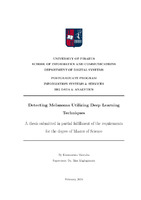| dc.contributor.advisor | Maglogiannis, Ilias | |
| dc.contributor.advisor | Μαγκλογιάννης, Ηλίας | |
| dc.contributor.author | Mantalia, Konstantina | |
| dc.contributor.author | Μανταλιά, Κωνσταντίνα | |
| dc.date.accessioned | 2024-07-19T06:14:12Z | |
| dc.date.available | 2024-07-19T06:14:12Z | |
| dc.date.issued | 2024-02 | |
| dc.identifier.uri | https://dione.lib.unipi.gr/xmlui/handle/unipi/16618 | |
| dc.identifier.uri | http://dx.doi.org/10.26267/unipi_dione/4040 | |
| dc.format.extent | 69 | el |
| dc.language.iso | en | el |
| dc.publisher | Πανεπιστήμιο Πειραιώς | el |
| dc.rights | Αναφορά Δημιουργού-Μη Εμπορική Χρήση-Όχι Παράγωγα Έργα 3.0 Ελλάδα | * |
| dc.rights | Αναφορά Δημιουργού-Μη Εμπορική Χρήση-Όχι Παράγωγα Έργα 3.0 Ελλάδα | * |
| dc.rights.uri | http://creativecommons.org/licenses/by-nc-nd/3.0/gr/ | * |
| dc.title | Detecting melanoma utilizing deep learning techniques | el |
| dc.type | Master Thesis | el |
| dc.contributor.department | Σχολή Τεχνολογιών Πληροφορικής και Επικοινωνιών. Τμήμα Ψηφιακών Συστημάτων | el |
| dc.description.abstractEN | Melanoma is a form of skin cancer that, although it accounts for a very small percentage of skin malignancies (about 1%), is considered the most dangerous form because of its tendency to spread quickly, eventually leading to death. Diagnose is often difficult and specialists in the field have to resort to invasive methods, such as biopsy, a histological examination, which is considered very accurate, yet it’s also quite painful for the patients. Recent advancements leveraging data and enhanced computational capabilities are promising to offer medical practitioners guidance towards reliable diagnoses, potentially reducing reliance on invasive procedures. This thesis aims to utilize dermatological images obtained from the ISIC archive to train Deep Learning models for the detection of melanoma. A total of five models will be trained, with one being unpretrained and the remaining four belonging to established architectures and pretrained. At the conclusion of this research will be the presentation of experimental results and a comparative analysis of the models employed. Lastly, a web application was developed using the Python library Streamlit. This application allows users to upload a skin lesion image, select the desired model for analysis, and receive the corresponding result. | el |
| dc.contributor.master | Πληροφοριακά Συστήματα και Υπηρεσίες | el |
| dc.subject.keyword | Deep learning | el |
| dc.subject.keyword | Neural networks | el |
| dc.subject.keyword | ISIC | el |
| dc.subject.keyword | Melanoma classification | el |
| dc.subject.keyword | Skin cancer | el |
| dc.subject.keyword | Skin lesion | el |
| dc.subject.keyword | ResNet | el |
| dc.subject.keyword | VGGNet | el |
| dc.subject.keyword | MobileNet | el |
| dc.subject.keyword | InceptionNet | el |
| dc.date.defense | 2024-02 | |



